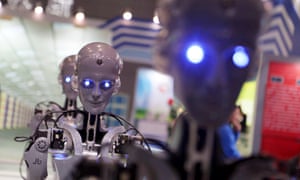
f you wanted relief from stories about tyre factories and steel plants closing, you could try relaxing with a new 300-page report from Bank of America Merrill Lynch which looks at the likely effects of a robot revolution.
But you might not end up reassured. Though it promises robot carers for an ageing population, it also forecasts huge numbers of jobs being wiped out: up to 35% of all workers in the UK and 47% of those in the US, including white-collar jobs, seeing their livelihoods taken away by machines.
Haven’t we heard all this before, though? From the luddites of the 19th century to print unions protesting in the 1980s about computers, there have always been people fearful about the march of mechanisation. And yet we keep on creating new job categories.
However, there are still concerns that the combination of artificial intelligence (AI) – which is able to make logical inferences about its surroundings and experience – married to ever-improving robotics, will wipe away entire swaths of work and radically reshape society.
“The poster child for automation is agriculture,” says Calum Chace, author of Surviving AI and the novel Pandora’s Brain. “In 1900, 40% of the US labour force worked in agriculture. By 1960, the figure was a few per cent. And yet people had jobs; the nature of the jobs had changed.
“But then again, there were 21 million horses in the US in 1900. By 1960, there were just three million. The difference was that humans have cognitive skills – we could learn to do new things. But that might not always be the case as machines get smarter and smarter.”
What if we’re the horses to AI’s humans? To those who don’t watch the industry closely, it’s hard to see how quickly the combination of robotics and artificial intelligence is advancing. Last week a team from the Massachusetts Institute of Technology released a video showing a tiny drone flying through a lightly forested area at 30mph, avoiding the trees – all without a pilot, using only its onboard processors. Of course it can outrun a human-piloted one.
MIT has also built a “robot cheetah” which can jump over obstacles of up to 40cm without help. Add to that the standard progress of computing, where processing power doubles roughly every 18 months (or, equally, prices for capability halve), and you can see why people like Chace are getting worried.

No comments:
Post a Comment